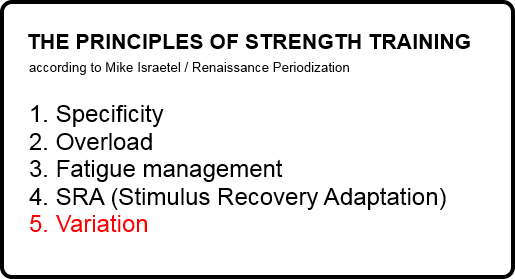Variation in exercises is a way to provide the body with new training stimuli. But your muscles don’t get bored as easily as you might think. Switching exercises often can actually backfire.
THE NEUROLOGICAL FACTOR
As soon as you do a new exercise, you quickly get better at that particular exercise. That improvement in your technical skill – because it actually is – ensures that you can perform the exercise more heavily. This is based on neurological factors, adjustments in the central nervous system.
In the initial phase of a new training program these neurological factors make a greater contribution to your strength gain than the increase in muscle mass [ i ] . In fact, if your progress comes to an abrupt halt after a few weeks, that means nothing more than that you’ve mastered the exercise ‘nicely’.
At this point, it’s tempting to switch to another exercise, where you can make the same number of weeks of progress. In fact , this is a sham progression [ ii ] . Because while you get better and stronger in this exercise, you forget your old exercise, as it were. You’ll find out when you implement it back into your training program and have to start practically from scratch again.
You can switch exercises every few weeks for a while, and get better at that new exercise every time. But if you look in the mirror after half a year, or if you test yourself on a reference exercise such as the squat, bench press or deadlift, you hardly notice any progress.
THE SEMBLANCE OF PROGRESS
What you’ve actually done is pick the low-hanging fruit. A favorite method of many personal trainers to give the appearance of progress. In fact, you have mainly trained your central nervous system. Now it’s time to let your muscles reap the benefits of that improved neural efficiency. If you don’t, you undermine the training principle of overload, a prerequisite for muscle growth. And overload is above variation in the hierarchy of strength training principles.
 Variety is not the main principle of strength/hypertrophy training. Thus, it is subordinate to specificity and overload.
Variety is not the main principle of strength/hypertrophy training. Thus, it is subordinate to specificity and overload.PROGRESSIVE OVERLOAD
In strength training, your primary goal is to gradually train harder, i.e. more weight and/or more repetitions, with the same exercise. We call that progressive overload. In this article an example of how you can add weight.
The fact that your body is able to lift heavier weights is due to adjustments (adaptations) in the muscles, caused during previous training sessions. In this way, overload is in itself a way to ‘surprise’ your body. Coach Mike Israetel puts this aptly:
Overload is the biggest form of novelty in essence. [ iv ]
And about variation versus overload:
Your number one goal in training is NOT to shock the body and change things up. Your number one goal is to keep stable conditions and progressively overload. [ v ]
Frequently doing new exercises has another disadvantage. New exercises cause more muscle damage and that undermines your overall recovery capacity [ iii ] . Coach Menno Henselmans therefore concludes:
Implementing variety in your training just for the sake of it is more likely to be harmful than helpful. [ iii ]
In short, progressive overload is the key to muscle growth in the long term. The ‘surprise’ for your muscles is in the heavier training, not in constantly doing new exercises.
ADVICE
So it is better to give an exercise a chance for a while for maximum strength gain and muscle growth. Some basic exercises, such as the bench press and squat, more or less always stay in your training schedule.
Do you end up on a training plateau after a while? Then don’t change exercises right away, but increase your training volume (so do more sets), as your body may have become accustomed to your current workload and it no longer offers a challenge. And training courses must be challenging if they are to create a growth stimulus.
When adjusting training variables such as volume, first check whether your recovery is in order, something in which non-training factors, in particular nutrition, sleep and stress level, also play an important role. So don’t ‘just’ start doing more sets.
WHEN YOU CAN (OR SHOULD) VARY IN EXERCISES
Are your training volume and recovery all right? And are you hardly making any progress anymore? Then there may be training staleness, which is a good time to introduce some variation: different exercises, different technique, different rep ranges and the like. By training staleness, Mike Israetel means that a certain way of training stimulates fewer and fewer adaptations over time.
At some point even just linearly overloading isn’t enough. [ iv ]
In intermediate and advanced bodybuilders, training steeless usually occurs after a few mesocycles of unchanged training, i.e. after about three or four months. Even then you don’t have to change your entire training program, but only where necessary. After all, if your entire schedule has stopped working, the cause is probably in your overall recovery.
There may be other valid reasons to switch exercises, for example if you don’t think an exercise is effective enough, if you don’t like an exercise (it doesn’t have to be just no pain, no gain), if you have an injury or if the programming of your training – for any reason – changes drastically (for example, full body instead of split, so that you have to do more compound exercises).
If you like variation, make sure your training program includes a wide range of exercises, but try to stick to those exercises as much as possible: variation should never be at the expense of the principle of overload.
Last updated on August 1, 2022.